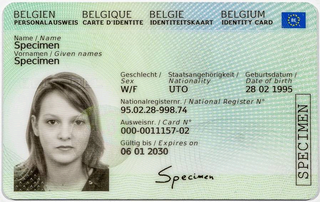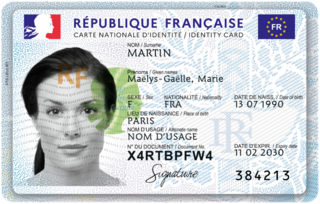
An identity document is a document proving a person's identity.

A Belgian identity card is a national identity card issued to all citizens of Belgium aged 12 years old and above.

The French national identity card is an official identity document consisting of an electronic ID-1 card bearing a photograph, name and address. While the identity card is non-compulsory, all persons must possess some form of valid government-issued identity documentation.

The Czech national identity card is the identity document used in the Czech Republic, in addition to the Czech passport. It is issued to all citizens, and every person above 15 years of age permanently living in the Czech Republic is required by law to hold a valid identity card.

A travel document is an identity document issued by a government or international entity pursuant to international agreements to enable individuals to clear border control measures. Travel documents usually assure other governments that the bearer may return to the issuing country, and are often issued in booklet form to allow other governments to place visas as well as entry and exit stamps into them.

The Romanian identity card is an official identity document issued to every Romanian citizen residing in Romania. It is compulsory to obtain the identity card from 14 years of age. Although Romanian citizens residing abroad are exempt from obtaining the identity card, if they intend to establish a temporary residence in Romania, they may then apply for a provisional identity document, which is valid for one year (renewable).

A Norwegian passport is the passport issued to nationals of Norway for the purpose of international travel. Beside serving as proof of Norwegian citizenship, they facilitate the process of securing assistance from Norwegian consular officials abroad.

The Estonian identity card is a mandatory identity document for citizens of Estonia. In addition to regular identification of a person, an ID-card can also be used for establishing one's identity in electronic environment and for giving one's digital signature. Within Europe as well as French overseas territories, Georgia and Tunisia the Estonian ID-card can be used by the citizens of Estonia as a travel document.

The Croatian identity card is an identity document issued in Croatia. Any Croatian citizen who is resident in Croatia can obtain an ID card and it is compulsory for all citizens over the age of 18. This document is issued by the police on behalf of the Ministry of the Interior.

Hungarian identity cards are not compulsory for Hungarian citizens, although they may be obtained by anyone after birth. However, every citizen from 14 years of age must have at least one of the three identity documents: national identity card; passport, under the age of 17 years; or a photo-card driving licence for anyone over 17 years old. Citizens can travel anywhere in Europe as well as to Georgia, French overseas territories, Montserrat, Turkey and organized tours to Tunisia using only this identity card.

The Slovak citizen ID card is the identity document used in the Slovak Republic, in addition to the Slovak passport. It is issued to all citizens, and every person above 3 years of age permanently living in Slovakia. It is required by law to hold a valid identity card.

The Bulgarian identity card is a compulsory identity document issued in Bulgaria. The document is issued by the police on behalf of the Ministry of Interior and is the main form of identification on the territory of the Republic of Bulgaria. All Bulgarians are obliged by law to carry their identity cards with them at all times and are subject to fines should they not.

The Dutch identity card is an official non-compulsory identity document issued to Dutch nationals in the European part of the Netherlands and certain diplomatic missions. It has similar dimensions and structure as those of a regular bank card.

The Swiss identity card in its current form dates back to July 1994. It is in the form of a plastic photocard. It can be used as a travel document when travelling within European Free Trade Association or to the European Union, the European microstates, Georgia, Turkey, and on organized tours to Tunisia.

The Finnish identity card is one of two official identity documents in Finland, the other being the Finnish passport. Any citizen or resident can get an identification card. Finnish citizens will get indication of citizenship on the card. It is available as an electronic ID card, which enables logging into certain services on the Internet, local computers or adding digital signatures into LibreOffice ODF documents or creating DigiDoc formatted containers that also allows encryption during content transfer. ID card is applied at a police station and it is issued by the police.

The German Identity Card is issued to German nationals by local registration offices in Germany and diplomatic missions abroad, while it is produced at the Bundesdruckerei in Berlin.

Sara Slovenian identity card is issued to Slovenian citizens. It can be used as a travel document when visiting countries in Europe, as well as Georgia, French overseas territories, Montserrat and organized tours to Tunisia.

National identity cards are identity documents issued to citizens of most European Union and European Economic Area (EEA) member states, with the exception of Denmark and Ireland. As a new common identity card model harmonized the various formats in use from 2 August 2021, with older ID cards currently being phased out according to EU Regulation 2019/1157.

The Latvian identity card, also known as Personal certificate, is an officially recognised biometric identity document issued to Latvian citizens. They are also valid for travel within Europe, Georgia, French Overseas territories, Montserrat and organized tours to Tunisia.

The Icelandic identity card, is a voluntary identity document issued by Registers Iceland. It is one of three official identity documents issued by the Icelandic Government, along with the Icelandic passport and Icelandic driving licence. It is only issued to Icelandic citizens and may indicate citizenship, so that it can be used as a travel document facilitating freedom of movement within the European Union and the European Free Trade Association.


















